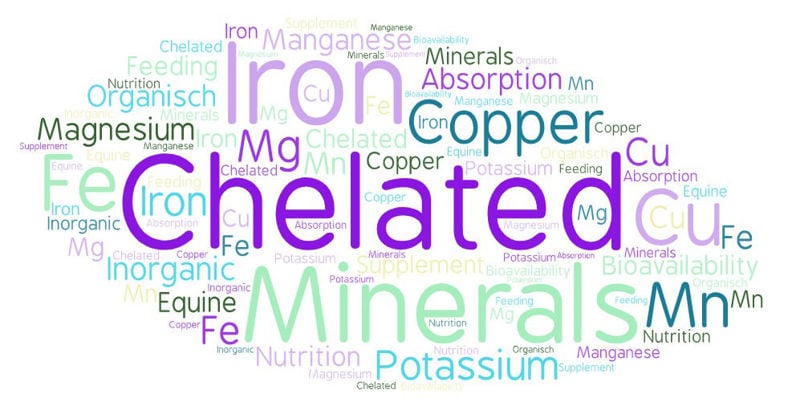Anouk Frieling, Senior Nutritionist
Minerals have important functions in the horse’s body and therefore are an essential part of the horses diet. Forage is the main mineral supplier in the diet of a horse and the mineral level in forage depends on the quality of the forage. Not every horse has access to high quality forage and therefore to meet requirements the diet is commonly supplemented with a vitamin and mineral supplement.
Minerals are important for all horses, but especially for young growing and exercising horses. The minerals Copper (Cu), Iron (Fe), Potassium (K), Magnesium (Mg) and Manganese (Mn) are involved in the production of hormones, enzyme and neural transmission, immunity, maintaining energy balance and development of the body. When mineral requirements (table 1) are not met issues can develop that influence the homeostasis of the body.
During the last decade there has been an increased interest in the use of chelated minerals in animal and equine nutrition, mainly because chelates improve the absorption of minerals in the digestive tract which results in reduced mineral excretion in the faeces. This has a positive effect on the animal and the environment which has been an important topic over recent years.

Table 1. The daily mineral requirement for maintenance and exercise for a 500 kg horse. Mg and K in grams per day and Cu, Fe and Mn in milligrams per day (NRC, 2007).
What are chelated minerals?
Feed and mineral supplements either contain inorganic or organic minerals. Inorganic minerals are connected to an oxide or sulphate group, for instance Zinc Sulphate and Manganese Oxide are inorganic minerals in feedstuff. Organic minerals are also called chelated minerals. These minerals are joined or ‘chelated’ with amino acids, such as Glycerine, Lysine or Cysteine.
Benefits of chelated minerals for horses
During digestion, inorganic minerals are able to break up (dissociate) due to the pH in the gastrointestinal tract. Dissociated minerals interact with other dietary components and are also able to interact with other minerals in the digesta for example Zinc has an effect on the Copper absorption in the digestive tract. Part of the minerals can be absorbed through the intestinal wall, however, the dissociated inorganic minerals that interact with other dietary components can form insoluble compounds which the body is not able to digest.
The chelation of minerals prevents the minerals from dissociating during the digestive process and therefore reduces interactions with other substances such as other minerals and vitamins. Chelates neutralise the mineral and therefore make it possible for the nutrients to move freely in the body, resulting in higher absorption rates of the minerals in the gastrointestinal tract.
This suggests that the structure of the chelated minerals is more stable as opposed to the structure of the inorganic minerals, therefore it is assumed that chelated minerals are more bioavailable than inorganic minerals. This means that the body is able to absorb a greater amount of the minerals in a chelated from in comparison to the minerals which are bound to a sulphate or oxide group. Pig studies have shown that the bioavailability of chelated Iron is between 1.3 and 1.85 greater than the inorganic form of Iron. Chelated minerals are especially beneficial for horses that require a higher level of minerals such as young horses, exercising horses and broodmares, because of their higher bioavailability.
As mentioned before, one of the benefits of chelated minerals is that it has a positive effect on the environment due to the higher absorption which results in a decreased excretion of minerals in the faeces of the horse. A higher bioavailability of minerals would also mean that the daily feed and supplement intake can be reduced to meet the daily mineral requirement of the horse, which would make feed and supplements more efficient. Inorganic and chelated mineral comparison studies, involving horses, have shown that chelated minerals are able to avoid mineral imbalances in the body of the horse. Studies also suggest that supplementing complexed minerals may be beneficial for maintaining muscle health in young exercising horses. In addition, supplementing the horse’s diet with a joint supplement containing chelated minerals found it helped to support soundness.
Summary
Overall, minerals have important functions in the body of the horse. There are two types of minerals; inorganic and organic or chelated minerals. Chelated minerals are minerals chelated with amino acids. The structure of these minerals is more stable than the structure of inorganic minerals. Therefore, chelated minerals are more bioavailable allowing the horse to absorb a higher concentration of minerals. This proves to have beneficial effects for the horse and for the environment due to less excretion of minerals in the faeces.
If you would like any advice, please contact our Equine Nutrition Team who would be happy to help you. You can email [email protected] or call our freephone advice line on 0800 585525.


